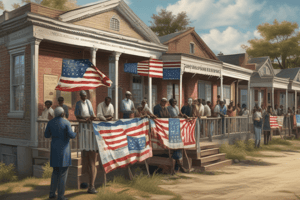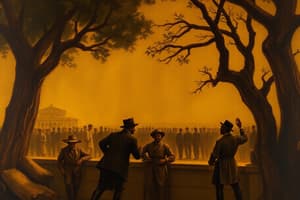Podcast
Questions and Answers
Which of the following BEST describes the primary goal of the Black Codes implemented in the Southern states after the Civil War?
Which of the following BEST describes the primary goal of the Black Codes implemented in the Southern states after the Civil War?
- To restrict the rights and freedoms of formerly enslaved people, maintaining a system of racial hierarchy and control. (correct)
- To provide formerly enslaved people with land ownership opportunities, fulfilling the promise of '40 acres and a mule.'
- To ensure formerly enslaved people had access to education and vocational training.
- To integrate formerly enslaved people fully into Southern society by granting them equal rights.
How did the system of sharecropping perpetuate a cycle of poverty for many formerly enslaved people and poor whites in the South during Reconstruction?
How did the system of sharecropping perpetuate a cycle of poverty for many formerly enslaved people and poor whites in the South during Reconstruction?
- The government heavily subsidized sharecropping, guaranteeing a stable income for all participants.
- Sharecropping contracts were always fair and transparent, ensuring a profitable outcome for both landowners and tenants.
- Landowners systematically inflated costs for rent, supplies, and other expenses, trapping tenants in inescapable debt. (correct)
- Sharecropping provided economic independence, enabling tenants to accumulate wealth over time.
What was the significance of the 14th Amendment in relation to the Dred Scott decision?
What was the significance of the 14th Amendment in relation to the Dred Scott decision?
- It overturned the Dred Scott decision by granting citizenship to all persons born or naturalized in the United States, including formerly enslaved people. (correct)
- It formally repealed the 13th Amendment, reinstating slavery in Confederate states.
- It had no direct impact on the Dred Scott decision.
- It upheld the Dred Scott decision, affirming that African Americans were not citizens.
President Andrew Johnson's approach to Reconstruction faced strong opposition from the Radical Republicans in Congress. Why?
President Andrew Johnson's approach to Reconstruction faced strong opposition from the Radical Republicans in Congress. Why?
Which of the following BEST describes the impact of the Compromise of 1877 on Reconstruction?
Which of the following BEST describes the impact of the Compromise of 1877 on Reconstruction?
What was the primary purpose of the Military Reconstruction Act of 1867?
What was the primary purpose of the Military Reconstruction Act of 1867?
How did Southern states attempt to disenfranchise African American voters despite the passage of the 15th Amendment?
How did Southern states attempt to disenfranchise African American voters despite the passage of the 15th Amendment?
What was the significance of the Supreme Court's ruling in Plessy v. Ferguson?
What was the significance of the Supreme Court's ruling in Plessy v. Ferguson?
How did the Panic of 1873 impact the Reconstruction efforts in the South?
How did the Panic of 1873 impact the Reconstruction efforts in the South?
During the Reconstruction era, what was the main objective of groups like the Ku Klux Klan (KKK)?
During the Reconstruction era, what was the main objective of groups like the Ku Klux Klan (KKK)?
Flashcards
13th Amendment
13th Amendment
Abolished slavery and involuntary servitude in the United States.
10% Plan
10% Plan
Lincoln's plan to readmit Confederate states if 10% of their population swore loyalty to the U.S.
Black Codes
Black Codes
Laws enacted in Southern states to restrict the freedoms of African Americans.
Freedmen’s Bureau
Freedmen’s Bureau
Signup and view all the flashcards
40 Acres and a Mule
40 Acres and a Mule
Signup and view all the flashcards
Sharecropping
Sharecropping
Signup and view all the flashcards
14th Amendment
14th Amendment
Signup and view all the flashcards
1867 Military Reconstruction Act
1867 Military Reconstruction Act
Signup and view all the flashcards
15th Amendment
15th Amendment
Signup and view all the flashcards
Jim Crow
Jim Crow
Signup and view all the flashcards
Study Notes
- The 13th Amendment abolished slavery.
Presidential Reconstruction (1865-1867)
- The 10% Plan stipulated that former Confederate states could rejoin the Union once 10% of their population swore allegiance to the U.S., Confederate leaders renounced slavery, and pledged their loyalty.
- The Radical Republicans believed President Johnson's approach to the South was too lenient.
- Johnson did not adequately protect formerly enslaved people.
- Southern states elected former Confederate leaders to the U.S. Congress.
Black Codes
- Black Codes mandated that formerly enslaved people possess passes for travel.
- Black Codes prohibited formerly enslaved people from owning land.
- Black Codes compelled many formerly enslaved people to work on their old plantations again.
- Formerly enslaved people were barred from voting or serving on juries.
Freedmen’s Bureau
- The Freedmen's Bureau offered aid, education, and assistance to formerly enslaved people in dealing with new employers, often their former masters.
- The Bureau struggled with insufficient funding and opposition from hostile Southerners.
40 Acres and a Mule
- General Sherman's Field Order 15 called for the confiscation of Confederate land.
- The order intended to provide formerly enslaved people with 40 acres of land and a mule.
Sharecropping
- Sharecropping involved formerly enslaved people leasing land in exchange for giving landowners a percentage of their crops.
- Landowners further deducted money for housing, food, and farming supplies.
- This system trapped formerly enslaved people and many poor whites in continuous debt for generations.
Congressional Reconstruction (1867-1877)
- Republicans were angered by the Black Codes.
- Republicans gained over a 2/3 majority in both houses of Congress in the 1866 election.
- The Civil Rights Bill of 1866 was passed to overturn the Black Codes.
14th Amendment
- The 14th Amendment granted citizenship to formerly enslaved people.
- The 14th Amendment overturned Dred Scott.
- The 14th Amendment ensured due process and equal protection under the law.
- The 14th Amendment blocked former Confederate officers from holding state and federal office in Congress if formerly enslaved people were denied the right to vote.
1867 Military Reconstruction Act
- The act divided the South into five military districts run by the military.
- This lasted until Southern states were readmitted into the Union.
- President Johnson vetoed too many of these reconstruction laws and violated the Tenure of Office Act.
- The Tenure of Office Act stated that the president cannot fire a federal appointee without Congressional approval.
- Congress attempted to impeach Johnson but missed it by one vote.
15th Amendment
- The 15th Amendment granted universal male suffrage.
- All men could vote, regardless of race.
Post Reconstruction Era
- Hiram Rhodes Revels was the first African American in Congress.
- Scalawags was a derogatory term used by Southern Democrats for Southern Republicans.
- Carpetbaggers was the nickname for Yankees who moved South.
- Southern backlash against Reconstruction led to the creation of the KKK.
- Force Acts and KKK Acts aimed to dismantle the KKK.
- The Panic of 1873 caused Republicans and Northerners to prioritize the economy over Reconstruction in the South.
- The Compromise of 1877 resulted in Hayes and the Republican Party winning the presidential race in exchange for ending Reconstruction.
- Jim Crow laws, including poll taxes, literacy tests, and grandfather clauses, were used to deny African Americans the right to vote.
- Plessy vs. Ferguson established the "separate but equal" doctrine.
- The ruling led to segregation.
- Jim Crow laws equaled segregation.
- Brown vs. Board of Education ended segregation.
Studying That Suits You
Use AI to generate personalized quizzes and flashcards to suit your learning preferences.




